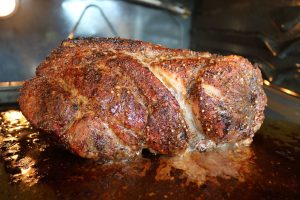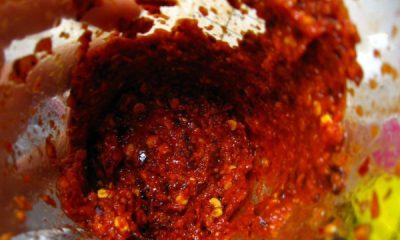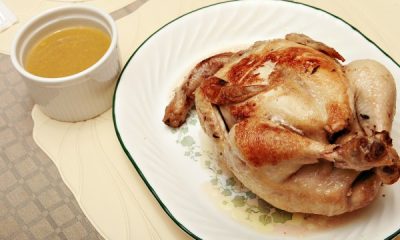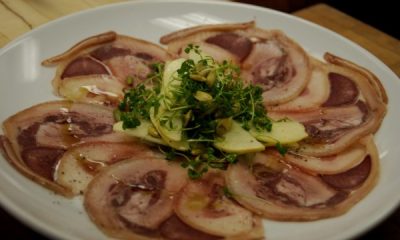Ask
All About Pork
What is the best cut of pork to make pulled pork with?
Pulled pork is a great place to start when learning about smoking and barbecue for a few different reasons. Pork shoulders and related cuts are relatively inexpensive, and the meat itself can be very forgiving. Undercook it (within the limits of safety) and it might be tough, but it will still taste good. Overcook it and you can still serve it with a smile. Pork allows you to practice your barbecue skills and still be able to eat your mistakes. (Brisket and ribs are not as forgiving.) But you need to make sure you start with the right cut of meat.
The Shoulder Cut
The most common cut for making pulled pork is the shoulder. The pork shoulder is the entire front leg and shoulder of a hog. In your grocery store, you will usually find this divided into two cuts, the Boston butt (also known as the Boston roast), and the picnic roast. Contrary to what the name implies, the butt comes from the upper part of the front shoulder and not the rear of the pig.
A full pork shoulder should weigh between 12 and 16 pounds. It will have a bone and joint plus a good helping of fat and collagen. Because of the intense fat marbling, pork shoulder doesn’t dry as quickly as other pieces of meat. The process of smoking causes the collagen to break down into simple sugars making the meat sweet and tender. In addition, during these long hours of smoking, much of the fat will melt away, keeping the meat moist. (Some experts will tell you that this is how to determine when the pork is done and to take it out of the smoker when most of the fat is gone.) This means you can skip all the traditional rubs, mops, and sauces and the pork will stand alone on the flavors of the meat and the smoke.

Boston Butt Vs. Picnic Roast
If you can’t find a whole pork shoulder at your local store you can get either or both of these cuts and you will still have just what you need. Both the Boston butt and picnic roast will weigh between 6 to 8 pounds individually, but the Boston butt will have less bone than the picnic. The picnic cut can come with or without the bone—you want one with the bone. The butt is the preferred cut for competition cooks and what most people are cooking in their backyards these days. It has a consistent, rectangular shape and is easy to handle. Although the picnic is more like an unprepared ham, it works just as well for pulled pork.
Preparing the Meat for the Smoker
No matter if you have the whole pork shoulder or the Boston butt and/or picnic roast, the meat you choose should have a good quantity of fat to make preparing it for smoking really easy. You can apply a rub to add flavor if you like, or you can simply put it in the smoker right out of the wrapping—just check it first for loose pieces of fat or skin and trim them off. Large, thick sections of fat should be trimmed down to about 1/4 to 1/2 inch in thickness. This will help to reduce the cooking time and let the smoke get to the meat better.
Adding a Rub to the Meat
If you choose to use a rub, do so liberally—remember that you are trying to flavor a large piece of meat (or two smaller pieces). To apply the seasoning, take the piece of pork, trimmed of unnecessary fat and skin, and rinse with cool water and pat dry. Then sprinkle the rub over the surface of the meat, massaging it in a bit. Make sure that every part is evenly covered—pork shoulders can have a very uneven surface so add the rub from every angle. The general rule is, what sticks is what stays.
For the best flavor, wrap the seasoned meat in plastic wrap and place in the refrigerator overnight. Make sure to remove the pork from the fridge early enough that it will come to room temperature before you place it in the smoker—cold meat will burn on the outside.
How do you make the perfect pork roast?
A perfect roast pork should have lovely moist, evenly cooked meat surrounded by crisp, sharp crackling. The crackling can be either left on or removed at the end of cooking and served separately.
The Best Cuts of Pork to Use
Loin, belly or leg make great joints for roasting. Choose fresh-looking meat preferably with a thick layer of fat. Many people shy away from joints with fat on them, but this fat helps keep the joint moist while cooking (dried out pork is one of the major faults when cooking pork) and helps with the flavor, you don’t have to eat it unless of course, you want to. Free range and organic pork will always have a thick layer of delicious pork fat.
Joints like shoulder and collar are better slow cooked.
How Much Pork Do You Need?
For 4 – 6 people you will need about 1 kilo of meat (including fat). Never worry if you have too much, pork is delicious cold in sandwiches.
Cook for 25 minutes per 450g/1lb, plus add a further 25 minutes at 200°C /400°F/ Gas 6.
These temperatures are based on a conventional oven, adjust accordingly for your oven.
If possible, use a meat thermometer to ensure the pork is cooked right through.
Pork should reach a minimum temperature of 62°C / 145°F according to the USDA.
Resting Roast Pork
An important part of cooking any meat is once it is removed from the oven the meat must rest. Once cooked, remove from the roasting tin and place onto a serving plate, cover loosely with foil and place in the oven with the door slightly ajar.
If you need to keep the oven hot (i.e., for cooking potatoes or maybe Yorkshire Pudding then wrap the meat completely in foil and keep in a warm place.
Important Tips Before Cooking the Pork and for Crisp Crackling
- If the pork needs to be stored before cooking, leave it unwrapped in the fridge on a lower shelf. Pork cooks much better when the skin thoroughly dried and a must if you want crisp crackling, so uncovered is best.
- At the time of cooking, the pork should be at room temperature, not cold straight from the fridge so remove for several hours and leave covered in a cool, not warm, place.
- Using kitchen paper, dry the pork thoroughly including the skin. Always throw the paper away once used for hygiene reasons.
- Even if your butcher has already scored the skin, it helps to add a few extra slashes.
- Use a Stanley, or Craft Knife or very sharp paring knife to slash the skin to give a good clean cut.
- Do not cut through to the meat, half way down the fat is sufficient.
- Use your hand to massage the oil and the salt into the skin and make sure it runs into the cracks of the skin
- Always put the pork into a preheated oven and cook to the correct temperature. See below.





















